Wolverhampton Wanderers have managed just one point from their first seven Premier League matches, conceding 21 goals—an average of three per game.
This marks their worst start to a Premier League season since 2018/19, which was their first campaign back in the top flight after promotion.
Since 2018, Wolves have experienced their fair share of ups and downs, finishing as high as seventh and as low as 13th.
While they’ve struggled for consistency in recent years, they’ve usually managed to remain in mid-table.
However, they seem entirely off the pace this season.
In this tactical analysis and team-focused scout report, we’ll
analyzekey statistics from the current season, focusing on their defensive and attacking issues, attacking inefficiencies, and problems with progression.
Where Did Wolves’ Issues Start?
Wolves’ issues are rooted in their status as a ‘selling club’.
They have been known to develop great talents, especially among their Portuguese players.
Matheus Nunes was sold to Manchester City for €62m, weakening their midfield.
Pedro Neto followed, joining Chelsea for €60m, leaving a significant gap in their attack.
Defensive stability suffered when Rúben Neves departed for Al-Hilal for €55m, and Maximilian Kilman’s transfer to West Ham United for €47.5m further disrupted their backline.
The forward line was also weakened by Diogo Jota’s earlier move to Liverpool for €44.7m.
Morgan Gibbs-White’s transfer to Nottingham Forest for €29.5m, along with Nathan Collins’ move to Brentford for €26.85m, compounded their problems, stripping the squad of both defensive and creative depth.
While these transfers generated significant revenue, the Wolves have struggled to replace that quality, making it difficult to compete for higher positions in the league.
All of these players have left in recent seasons, a period in which the club’s decline has become more evident.
Wolves have traditionally excelled at buying under-the-radar players, but they have failed to produce new talent to fill the void left by these departures, contributing to their current struggles in the league.
Gary O’Neil Tactics & Philosophy
At Wolves, under Gary O’Neil’s tactics, they have implemented a counterattacking style, using pacey wide players to exploit spaces left by opposition defences.
His approach encourages quick transitions and the use of wide flanks to punish teams on the break and catch them off balance.
Defensively, O’Neil prioritises compactness and organisation, ensuring his team remains disciplined without the ball.
His sides maintain a low-risk shape in a 4-4-2, minimising the gaps between lines and half turns.
This focus on structure allows them to stay competitive even against stronger opponents, frustrating teams by denying them space to operate effectively.
Wolves Statistics For The 2024/25 Premier League Season
Wolverhampton Wanderers Shots Map
Despite attempting 75 shots and generating 8.58 xG, the Wolves have only managed nine non-penalty goals, slightly overperforming their xG.
However, the issue lies in creating situations that can generate more xG and increase their scoring opportunities.
For comparison, Southampton, currently 19th, has generated 8.3 xG, while Crystal Palace, in 18th, has 9.52 xG.
This puts Wolves in a reasonable range for xG among teams in the bottom portion of the table.
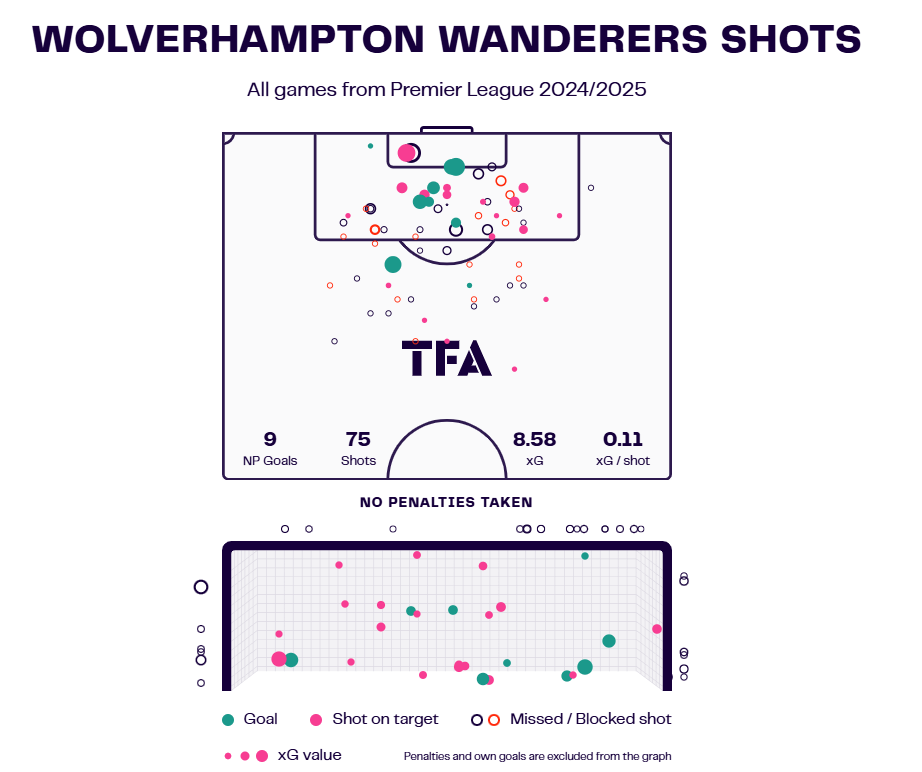
Wolverhampton Wanderers Shot Assists Map
The shot assist map shows Wolves have generated 4.89 xA (expected assists), leading to five assists so far.
The majority of passes leading to shots are concentrated on the right side, indicating a preference for attacking through that channel.
The low xA total reflects an underlying problem—Wolves are not creating enough goal-scoring opportunities.
At first glance, this xA figure might seem like data from 1-3 games, but considering it spans seven matches, it highlights a significant issue.
The lack of progressive passes into the penalty box over these matches is a critical weakness in their attack.
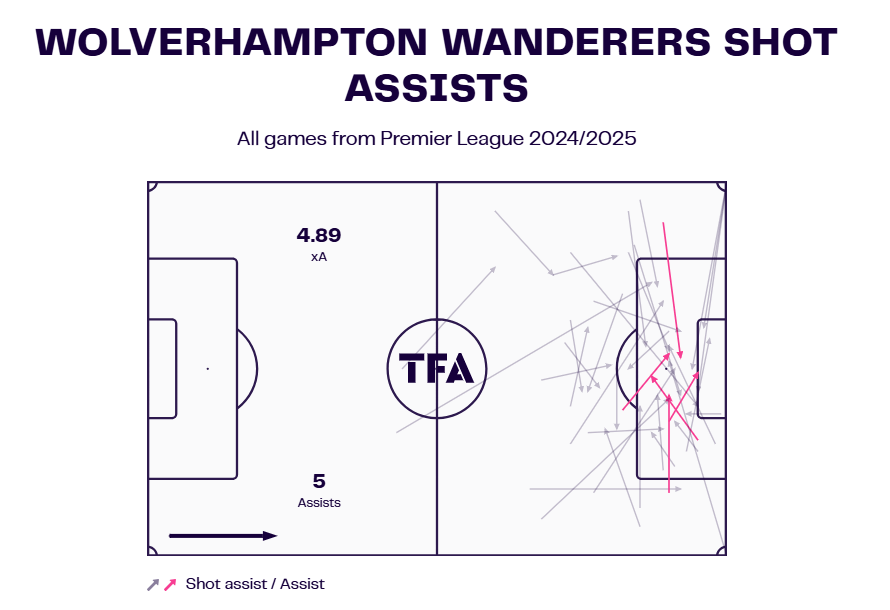
Wolverhampton Wanderers Penetrating Carries Map
Wolves have recorded 129 penetrating carries into the penalty area, showing their intent to attack directly.
These carries primarily originate from wide areas, highlighting their reliance on exploiting space down the flanks.
This is not necessarily an issue, as their total carries are comparable to Chelsea, who have 128.
The ability to penetrate the box and create chaos is present, but poor execution in the final pass has hindered their attacking efficiency.
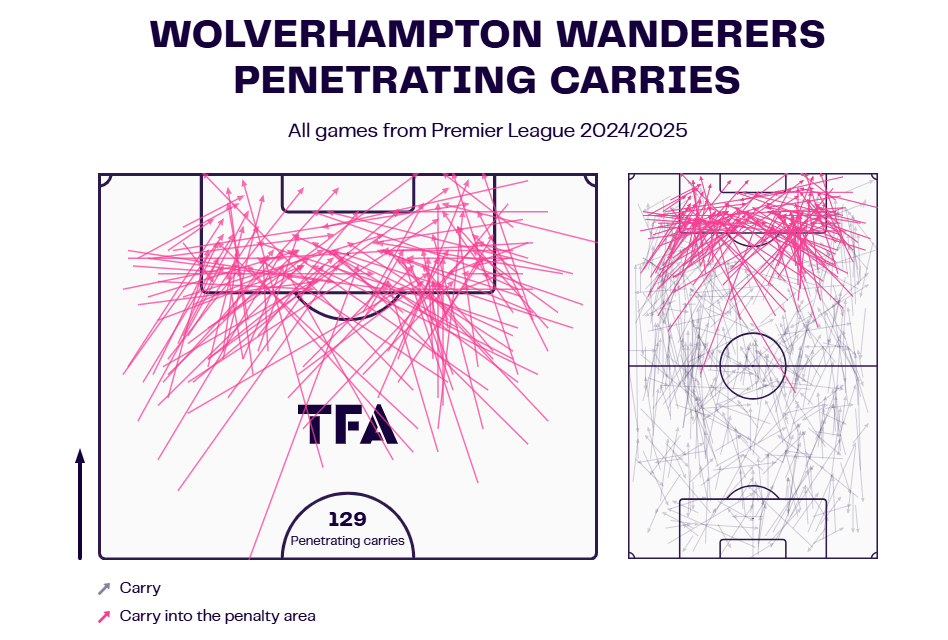
Wolverhampton Wanderers Crossing Zones Map
Wolves rely heavily on wide play, frequently delivering crosses from both flanks.
The left side has been more productive, with 38.6% of crosses reaching their target, compared to 29.8% from the right.
While these numbers align with those of top clubs—for example, Manchester United averages a 35.2% completion rate—the problem arises when wide play becomes the primary tactical focus.
With a tactical setup dependent on wide channels, the low success rate on the right suggests it may be time to reconsider the approach on that flank.
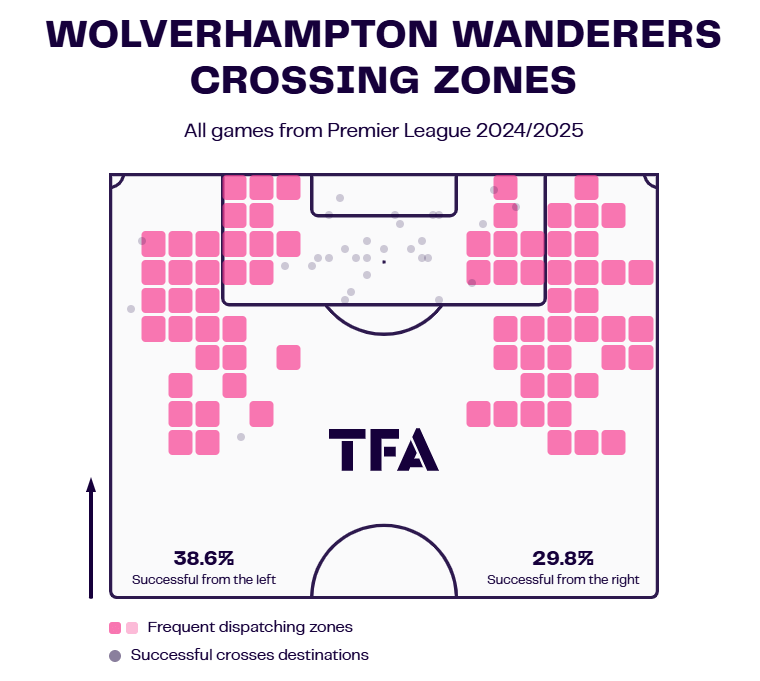
Wolverhampton Wanderers Ball Progression Map
The ball progression map highlights Wolves’ efforts to move the ball vertically, particularly through the flanks.
However, the high number of unsuccessful dribbles indicates challenges in breaking through opposition defences.
Once again, we see a heavy reliance on wide channels, with minimal effort to progress centrally.
This lack of central progression is likely linked to the departure of critical midfielders such as Neves, Nunes, and Gibbs-White, who previously provided a central presence.
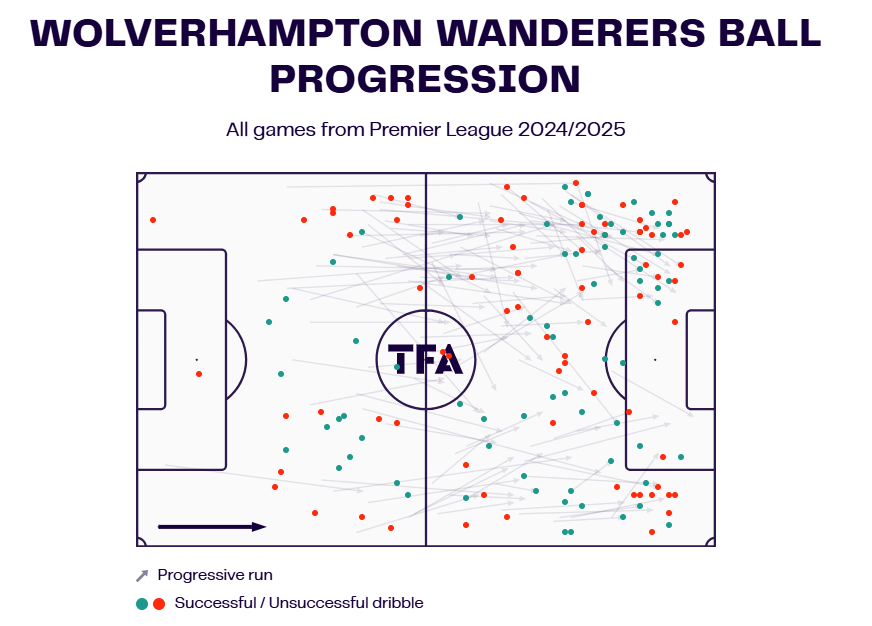
Wolverhampton Wanderers Shots Against Map
The shot map highlights the Wolves’ defensive struggles, with 9.23 xG conceded from the left and 6.91 xG from the right.
This imbalance underscores a vulnerability on the left side despite the team’s managing to block 25 shots across both flanks.
An interesting observation is the three goals conceded from outside the penalty area, suggesting that their defensive structure lacks discipline, leaving gaps for opponents to exploit.
This issue is reflected in the high xG faced and the 21 goals conceded so far this season.
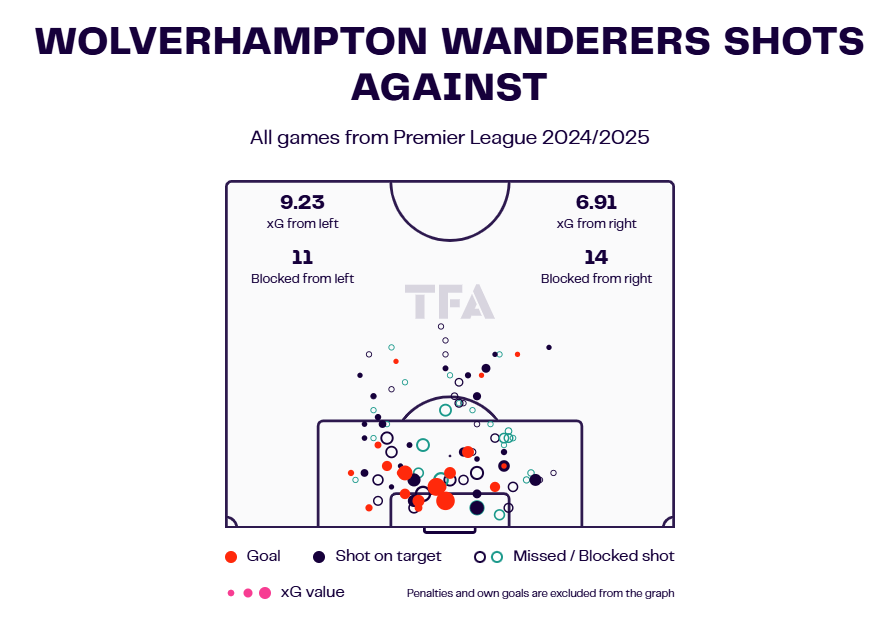
Wolverhampton Wanderers Shots Faced by GK Map
The Wolves’ goalkeeper has been under significant pressure this season, facing 16.13 xG, indicative of the quality and quantity of shots allowed.
The -2.87 prevented goals metric highlights underperformance in goal, meaning the goalkeeper has conceded more than expected based on the shots faced, further contributing to Wolves’ defensive issues.
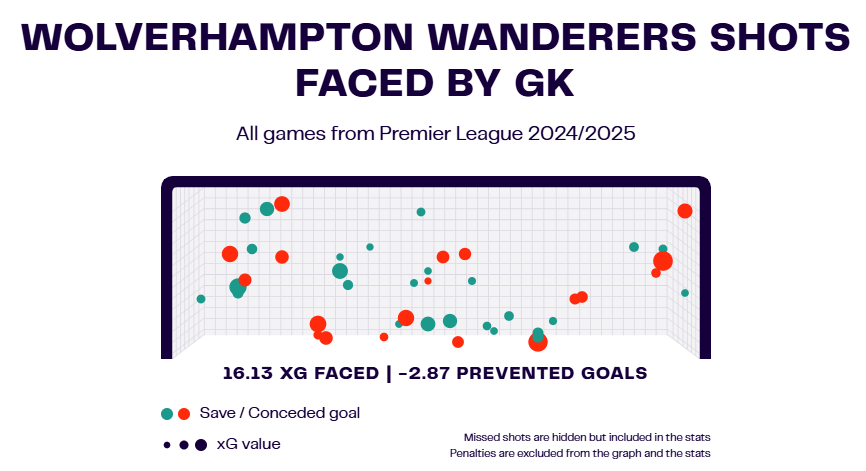
Wolves’ Tactical Issues
Defensive Set-Up
Wolves like to set up in a compact 4-4-2, where one of the wide players in the second defensive line pushes forward to create a front three when needed.
These players are marked with arrows in front of them to indicate where they would step into space if necessary.
The overall structure of their 4-4-2 isn’t the issue leading to so many goals; rather, the problem lies in their defensive organisation during transitions, where they often appear out of position.
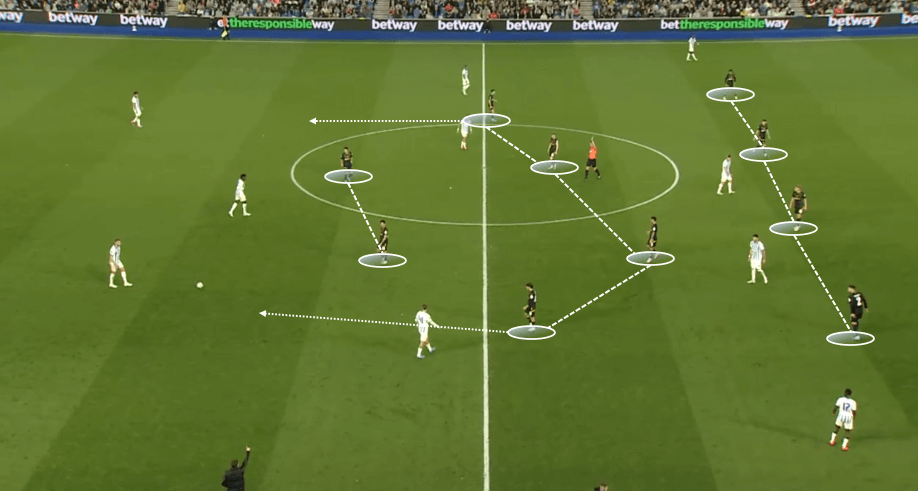
Defensive Flaws
In this image, we can see what it looks like when Wolves defend during a transition—entirely out of position.
Notice the five Wolves players clustered in the wide zone against just two Brentford players.
There should never be a 5v2 scenario in one area of the pitch unless it’s during the dying minutes of a match and the team is taking risks.
This unnecessary overload leaves gaps elsewhere, such as the yellow space inside and just above the penalty area.
A Brentford midfielder exploited this space, running in for a free header and putting them up 2-1 within a minute of play.
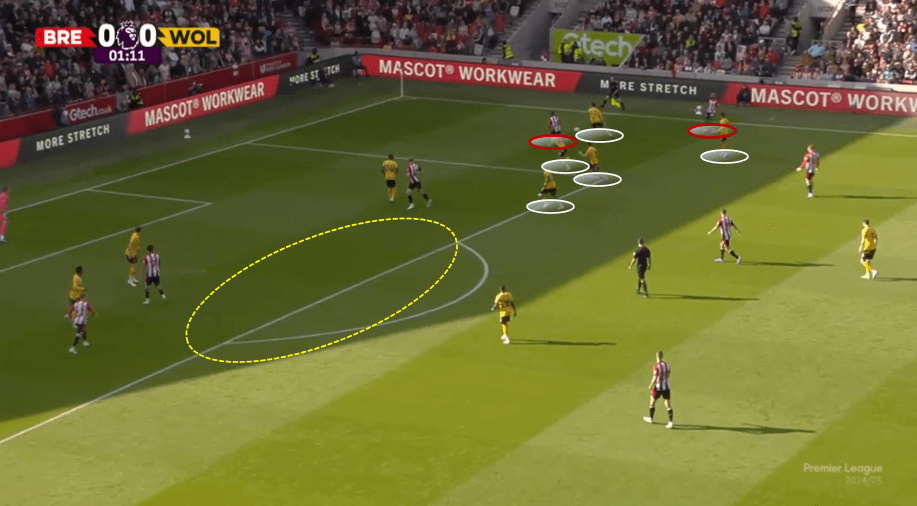
Another issue during transitions is their poor coordination.
Wolves seem out of sync when defending counterattacks, which is challenging for any club.
However, the holding midfielders need to be more in sync; ideally, one of them should occupy the space marked by the yellow circle.
This positioning would allow them to form a horizontal defensive line to cover the top of the box instead of being too close together vertically, which leaves crucial spaces exposed.
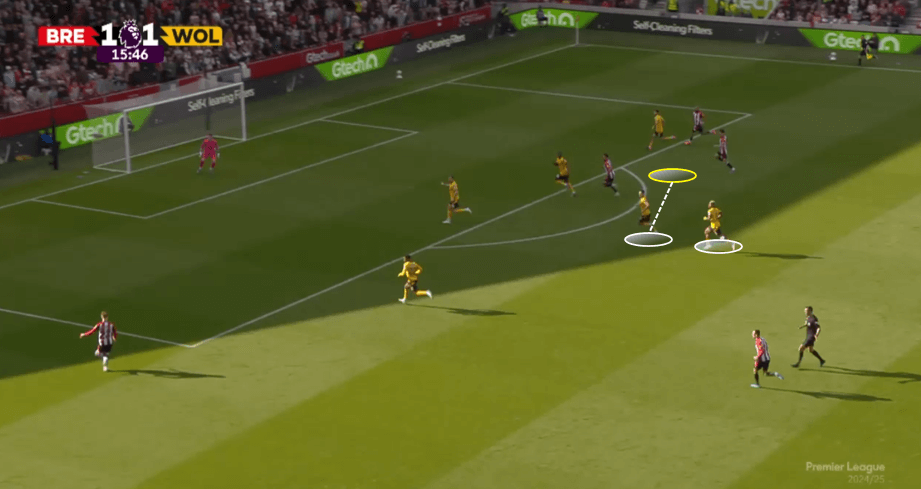
Attacking Setup
Their attacking setup features a three-man backline with a pivot midfielder tasked with creating opportunities going forward.
Wolves often play in a 3-3-4 or 3-4-3 formation with great fluidity, using wing-backs positioned extremely wide and high.
The pivot is given plenty of space to assist with the build-up and progress the ball forward.
However, as seen in the earlier stat graphics, there has been minimal ball progression through the centre, with most of it coming from the wide flanks.
This suggests that the single-pivot strategy during the build-up, combined with high and wide wing-backs, might not be effective in helping them score goals or create high-quality chances.
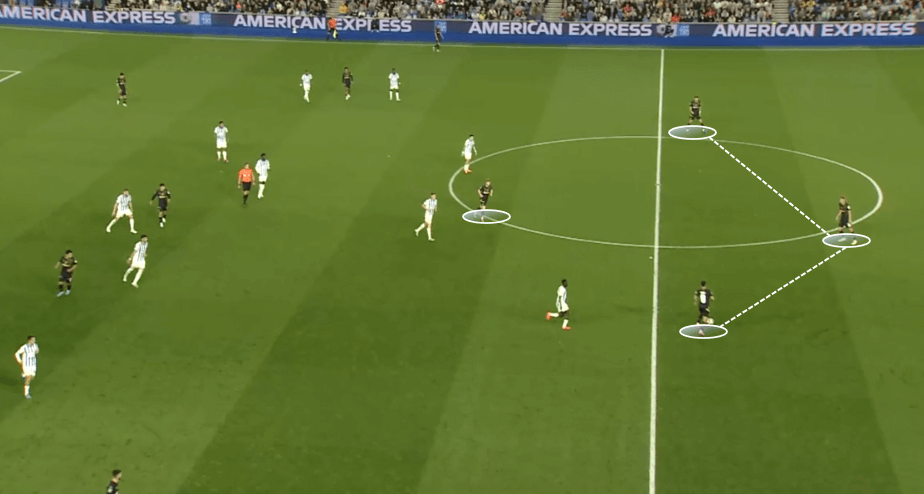
Attacking Flaws
One issue in their build-up is inconsistency.
In this instance, we see the three-back formation, but no midfielder drops into the yellow space to collect the ball, leaving a long horizontal line of attacking players.
This strategy has been successfully employed by teams like Inter Milan and Atlético Madrid in specific matches, but given the quality of Wolves’ players, it becomes much more challenging to execute effectively.
This setup allows the opponent to sit deeper, with no pressure in the middle third, forcing Wolves to resort to long balls over the top.
As a result, they rely heavily on precise timing from their attackers to make runs in behind without being caught offside.
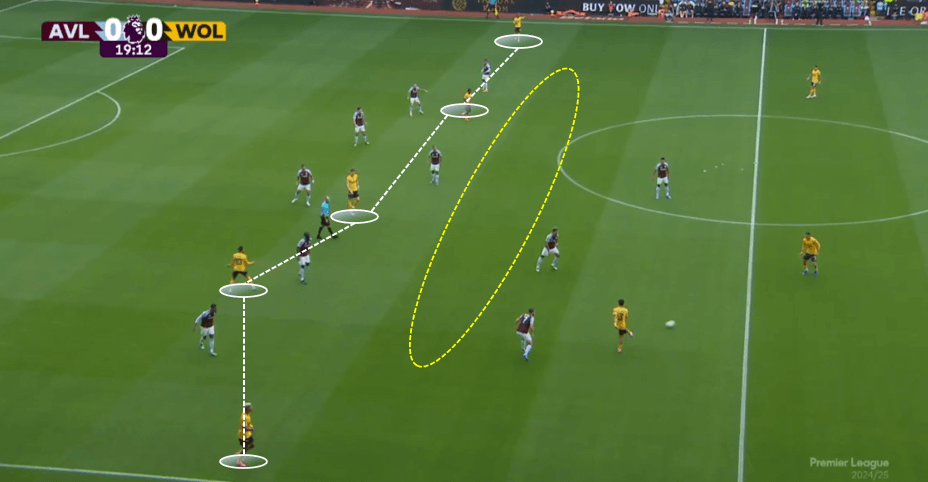
The use of wide play higher up the pitch hasn’t been effective enough.
Although Wolves generate many penetrating carries from wide areas, there is no central player to intercept these moves and create chaos in the opposition box.
As shown in the yellow space above, no one is positioned to exploit that area or disrupt the Liverpool defence.
Late runs from midfielders could help cause disorder, but a pure number 9 would also be beneficial for Wolves.
Teams can comfortably defend with zonal marking without an effective central presence, neutralising Wolves’ wide play and limiting their attacking threat.
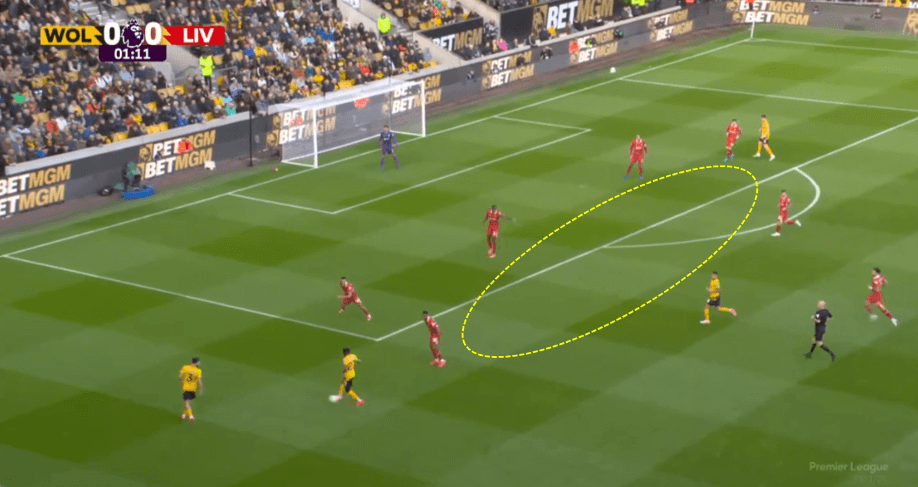
Conclusion
Wolves’ struggles this season reflect deeper issues both in terms of tactics and structure.
The loss of key players like Neves, Nunes, and Kilman has weakened their midfield and defence, leaving the squad without the quality needed to maintain consistency.
Gary O’Neil’s counterattacking system has promise, but poor coordination in defensive transitions has exposed the team, resulting in unnecessary goals conceded.
Their reliance on wide play without a strong central presence also limits attacking effectiveness, making it easy for opponents to defend with zonal marking.
To improve, Wolves need better organisation during transitions and more cohesion between the midfield and defence.
Additionally, diversifying their attack—whether by introducing a pure striker or creating more central progression—will be essential to generating high-quality chances.
Without these adjustments, they risk being stuck in the lower half of the Premier League table for the rest of the season or possibly relegation.

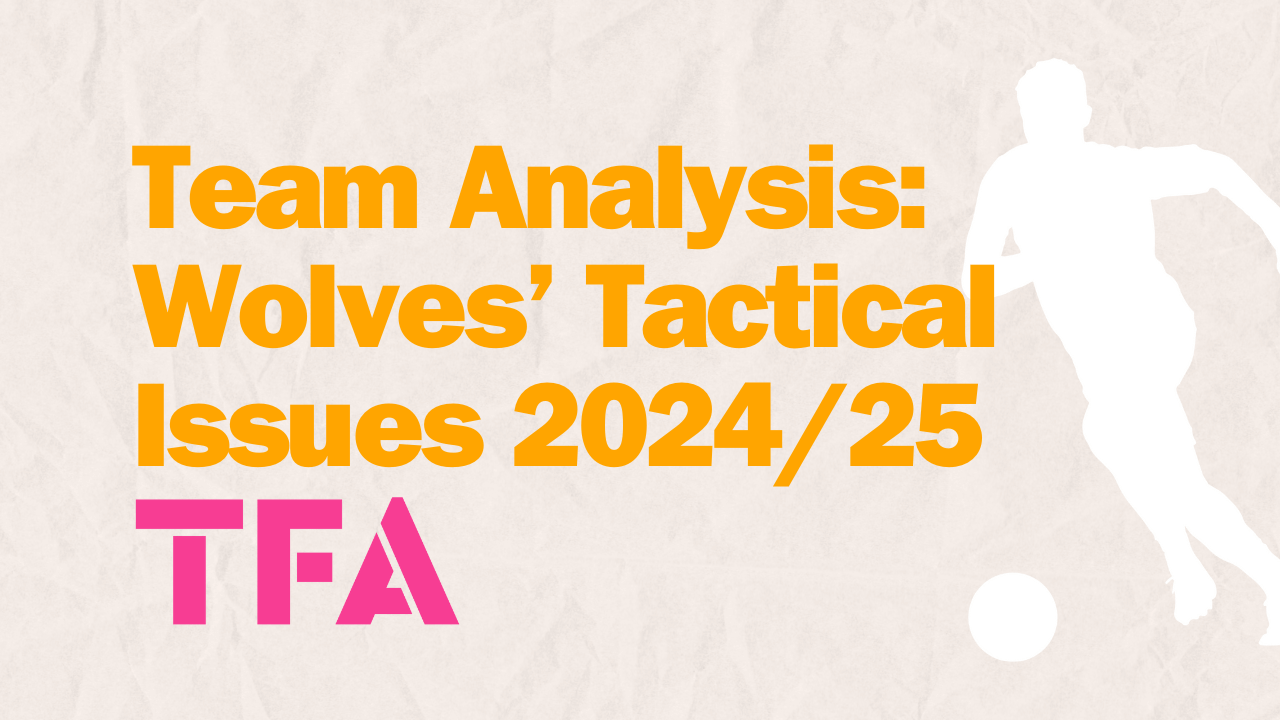



Comments